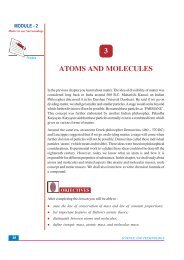Chapter 20. Perimeters and Area of Plane Figures
Chapter 20. Perimeters and Area of Plane Figures
Chapter 20. Perimeters and Area of Plane Figures
Create successful ePaper yourself
Turn your PDF publications into a flip-book with our unique Google optimized e-Paper software.
MODULE - 4<br />
Mensuration<br />
Notes<br />
EXPECTED BACKGROUND KNOWLEDGE<br />
<strong>Perimeters</strong> <strong>and</strong> <strong>Area</strong>s <strong>of</strong> <strong>Plane</strong> <strong>Figures</strong><br />
• Simple closed figures like triangles, quadrilaterals, parallelograms, trapeziums, squares,<br />
rectangles, circles <strong>and</strong> their properties.<br />
• Different units for perimeter <strong>and</strong> area such as m <strong>and</strong> m 2 , cm <strong>and</strong> cm 2 , mm <strong>and</strong> mm 2<br />
<strong>and</strong> so on.<br />
• Conversion <strong>of</strong> one unit into other units.<br />
• Bigger units for areas such as acres <strong>and</strong> hectares.<br />
• Following formulae for perimeters <strong>and</strong> areas <strong>of</strong> varioius figures:<br />
(i) Perimeter <strong>of</strong> a rectangle = 2 (length + breadth)<br />
(ii) <strong>Area</strong> <strong>of</strong> a rectangle = length × breadth<br />
(iii) Perimeter <strong>of</strong> a square = 4 × side<br />
(iv) <strong>Area</strong> <strong>of</strong> a square = (side) 2<br />
(v) <strong>Area</strong> <strong>of</strong> a parallelogram = base × corresponding altitude<br />
(vi) <strong>Area</strong> <strong>of</strong> a triangle = 2<br />
1 base × corresponding altitude<br />
(vii)<strong>Area</strong> <strong>of</strong> a rhombus = 2<br />
1 product <strong>of</strong> its diagonals<br />
(viii) <strong>Area</strong> <strong>of</strong> a trapezium = 2<br />
1 (sum <strong>of</strong> the two parallel sides) × distance between them<br />
(ix) circumference <strong>of</strong> a circle = 2 π × radius<br />
(x) <strong>Area</strong> <strong>of</strong> a circle = π× (radius) 2<br />
<strong>20.</strong>1 PERIMETERS AND AREAS OF SOME SPECIFIC<br />
QUADRILATEALS AND TRIANGLES<br />
You already know that the distance covered to walk along a plane closed figure (boundary)<br />
is called its perimeter <strong>and</strong> the measure <strong>of</strong> the region enclosed by the figure is called its<br />
area. You also know that perimeter or length is measured in linear units, while area is<br />
measured in square units. For example, units for perimeter (or length) are m or cm or mm<br />
<strong>and</strong> that for area are m 2 or cm 2 or mm 2 (also written as sq.m or sq.cm or sq.mm).<br />
You are also familiar with the calculations <strong>of</strong> the perimeters <strong>and</strong> areas <strong>of</strong> some specific<br />
quadrilaterals (such as squares, rectangles, parallelograms, etc.) <strong>and</strong> triangles, using certain<br />
formulae. Lets us consolidate this knowledge through some examples.<br />
458<br />
Mathematics Secondary Course

















